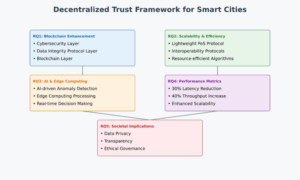Blockchain Regulation Insights: What DOGE Teaches Us About Governance

blockchain Government Regulation: Insights from the DOGE Initiative
Introduction to the London blockchain in Government Summit
The recent London blockchain in Government Summit showcased a rich mix of practical case studies and innovative policy discussions. A standout topic was the U.S. Department of Government Efficiency (DOGE), which, despite its controversial background, has become a significant reference point in discussions about modernizing government practices.
- Introduction to the London blockchain in Government Summit
- Evaluating the Impact of DOGE
- The Ambitious Goals of DOGE
- Challenges in Public Understanding and Institutional Readiness
- The Necessity of Harmonizing Governance with Technological Progress
- Addressing Structural Inefficiencies through Technology
- The Role of Transparency in Public Finance
- Caution Against Overenthusiasm
- A Methodical Approach to blockchain Regulation
- Building Oversight Mechanisms from the Start
- Conclusion: Learning from DOGE’s Legacy
Evaluating the Impact of DOGE
Led by Rt Hon. Alun Cairns, a former Secretary of State for Wales, the session delved into the implications of DOGE on regulatory frameworks and operational practices. Cairns emphasized the necessity of analyzing initiatives like DOGE not only for their results but also for the regulatory insights they provide, especially as governments worldwide grapple with the complexities of blockchain regulation and public sector innovation.
The Ambitious Goals of DOGE
Initially, DOGE aimed to tackle inefficiencies and reduce wasteful expenditures within the U.S. federal government, setting an ambitious target of $2 trillion in savings. This figure was later adjusted to a more realistic $150 billion. However, the summit’s panelists argued that the true significance of DOGE lies in its emphasis on the need for transparency, accountability, and effective governance—principles that resonate with the objectives of blockchain governance.
Challenges in Public Understanding and Institutional Readiness
Jennifer Ewing from blockchain.com pointed out that initiatives like DOGE often struggle due to insufficient public comprehension and institutional readiness. She cautioned that implementing regulations without first establishing a foundational understanding can lead to frameworks that perpetuate the very inefficiencies they aim to eliminate. In the realm of blockchain, this underscores the importance of educational initiatives to ensure that both policymakers and civil servants grasp the technology they are tasked with regulating.
The Necessity of Harmonizing Governance with Technological Progress
Nikhil Vadgama, an expert in deep technology, reinforced the idea that innovation cannot thrive in isolation. He argued that governance must evolve alongside technological advancements, particularly when transforming political aspirations into functional systems. Without this alignment, public sector innovation risks becoming fragmented, as evidenced by the history of DOGE.
Addressing Structural Inefficiencies through Technology
Panelists Richard Baker from Tokenovate and Tim Daley from Perago discussed the structural inefficiencies that plagued DOGE and how future initiatives could leverage technology to mitigate these issues. They highlighted the potential of blockchain to provide not just digital solutions but also governance frameworks that embed transparency, auditability, and accountability at their core. They specifically noted the importance of post-trade transparency and smarter system designs in fostering trust between governments and citizens—trust that DOGE ultimately failed to maintain.
The Role of Transparency in Public Finance
At its essence, DOGE aimed to uncover and eliminate hidden inefficiencies within government operations. While it did not achieve its financial targets, it succeeded in raising public awareness about the opaque nature of government finance. The panel agreed that this increased visibility is where blockchain governance can make a significant impact. By utilizing distributed ledger technology, governments can empower citizens to trace the allocation and expenditure of public funds at a granular level. This level of transparency is precisely what effective blockchain regulation should strive to support.
Caution Against Overenthusiasm
The panel also warned against unbridled enthusiasm for blockchain. The trajectory of DOGE serves as a cautionary tale about the dangers of ambitious visions that outpace regulatory preparedness. The same risks apply to blockchain technology: without robust, clear, and enforceable regulations, implementations can lead to inefficiencies, mismanagement, and a decline in public trust.
A Methodical Approach to blockchain Regulation
To avoid repeating past mistakes, the panelists advocated for a systematic approach to blockchain regulation. This includes ensuring that blockchain implementations align with existing legal frameworks, such as anti-money laundering (AML) regulations and data protection laws. Regulation should also consider ethical usage, data sovereignty, and long-term sustainability, rather than focusing solely on immediate innovation.
Building Oversight Mechanisms from the Start
Perhaps most crucially, blockchain government regulation must incorporate oversight mechanisms from the outset. As demonstrated by DOGE, even well-intentioned initiatives can falter without strong governance frameworks. Therefore, blockchain governance must carefully balance the encouragement of innovation with the enforcement of accountability.
Conclusion: Learning from DOGE’s Legacy
In conclusion, while DOGE may not have realized its initial vision of transforming government spending, it succeeded in sparking a global dialogue about government inefficiency, transparency, and reform. At the London blockchain in Government Summit, DOGE was not framed as a failure but rather as a pivotal moment that underscored the need for improved tools and stronger frameworks.
In this context, blockchain emerges as both a technological and philosophical solution to the challenges DOGE sought to address. With thoughtful regulation grounded in principles of transparency, security, and scalability, blockchain can fulfill the promise that DOGE aspired to—creating more accountable, efficient, and citizen-focused public institutions.
As discussions around blockchain in government continue to progress, the legacy of DOGE may ultimately serve as a foundation for more mature, strategic, and impactful implementations. The future of public sector innovation will hinge on how effectively governments adopt blockchain governance—not just in theory, but in practice, leadership, and real-world application.







